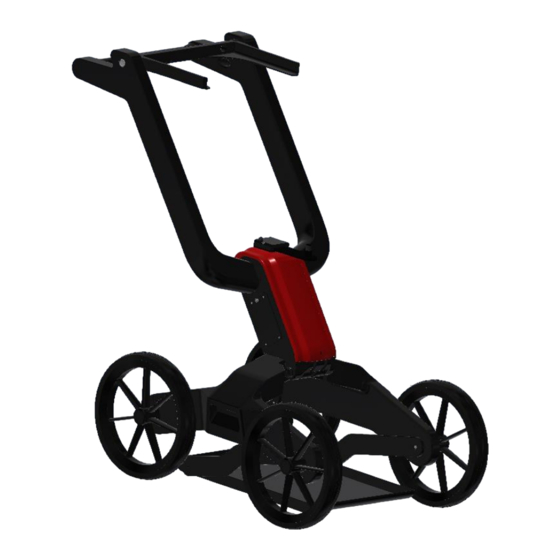
Table of Contents
Advertisement
Quick Links
Advertisement
Table of Contents

Summary of Contents for MALA EasyLocator
- Page 1 MALA EasyLocator WideRange Operating manual Version 1.0 Draft...
- Page 2 Draft www.malags.com...
-
Page 3: Table Of Contents
Table of Contents _________________________________________________ Introduction Unpacking and Inspection Repacking and Shipping Limited Warranty and Liability Important information regarding the use of this MALA GPR unit 6 Hardware and Start Up Hardware Start up Using the EasyLocator WideRange Surveying The settings menu... -
Page 4: Introduction
1 Introduction __________________________________________________ Thank you for purchasing the EasyLocator WideRange. The EasyLocator series of products is the most widely used GPR-system for utility detection, world-wide. The WideRange is the latest in a line of easy-to-use tools for the locating industry. It builds on its predecessors in terms of handling and user interface while incorporating the latest and most potent technology currently available. -
Page 5: Unpacking And Inspection
Any claims for shipping damage should be filed to the carrier. Any claims for missing equipment or parts should be filed with Mala GeoScience. 1.2 Repacking and Shipping If original packing materials are unavailable, the equipment should be packed with at least 80 mm of shock-absorbing material. -
Page 6: Important Information Regarding The Use Of This Mala Gpr Unit
1.4 Important information regarding the use of this MALA GPR unit According to the regulations stated in ETSI EN 302 066-1 (European Telecommunication Standards Institute): - The CX unit should not be left ON when leaving the system unintended. It should always be turned OFF when not in use. -
Page 7: Hardware And Start Up
__________________________________________________ 2.1 Hardware The EasyLocator WideRange is a bandwidth-extended GPR system designed for use with the EasyLocator ProCart Wide. The main components are the UWB-transducer(antenna), the monitor the mechanical carrying system and the batteries. The system is, preferable powered with one battery and data... - Page 8 Connect the Monitor to the transducer with the cable supplied, see picture below. Press and release the button the GPR-transducer, shortly, do keep it pressed. This will start up the unit; the LED’s on the panel will start to blink as well as the LED inside the button, see figure below.
- Page 9 After these simple steps the monitor will display the screen shown in figure below, and the system is ready for operation. Draft www.malags.com...
-
Page 10: Using The Easylocator Widerange
3 Using the EasyLocator WideRange The parts of the EasyLocator WideRange system are shipped separately. To get started unfold the ProCart, attach the EL Controller to the controller tray, attach the power/Ethernet cable, and mount the batteries in the battery bay (behind the red lid with the MALÅ... - Page 11 Starting from the top-right: The yellow circle with a cross-hair is indicating the GPS-status; red means that there’s no GPS attached or no satellites available, yellow means normal GPS accuracy (about 10m) and green means that the unit has been able to apply differential correction.
- Page 12 The bottom part of the screen shows some information about the ongoing survey. It’s self-explanatory except for the trigger- type field. The trigger type field explains what controls the data acquisition, there’s three different types of control; forward wheel, backward wheel and time triggering. Time triggering means that the unit collects data with certain frequency, normally 10 to 20 Hz;...
-
Page 13: Surveying
3.1 Surveying When a survey has been initiated the main menu changes, see figure below. Now the user may stop the survey, save a jpeg-image of the current screen check the velocity trough hyperbola fitting or save a GPS-marker on the current location. The radargram screen is split in two –... -
Page 14: The Settings Menu
3.2 The settings menu The settings menu is entered through the wrench button on the main menu; it is shown in figure below. Activating the green text-fields, but turning the push-turn button, and then depressing it gives the user means for changing the settings. - Page 15 Soil Type, is defining which ground velocity should be used when converting reflections from a specific time to a depth to be shown on the scales. Note that this type of instrument actually measures time of flight for electromagnetic waves, in ground. The depth displayed on the scales is estimations only.
-
Page 16: Easylocator Widerange Specifications
4 EasyLocator WideRange specifications __________________________________________________ Useful Bandwidth 80-960 MHz Time window > 250 ns Total weight incl. batteries 27 kg Power supply 12 V Li-ion rechargeable batteries Operating time 4 hours with standard batteries Operating temperature -20 to + 50... - Page 17 authority to operate the equipment. This equipment has been tested and found to comply with the limits for a Class B digital device, pursuant to Part 15 of the FCC Rules. These limits are designed to provide reasonable protection against harmful interference in a residential installation.
- Page 18 Under Industry Canada regulations, this radio transmitter may only operate using an antenna of a type and maximum (or lesser) gain approved for the transmitter by Industry Canada. To reduce potential radio interference to other users, the antenna type and its gain should be so chosen that the equivalent isotropically radiated power (e.i.r.p.) is not more than that necessary for successful communication.


Need help?
Do you have a question about the EasyLocator and is the answer not in the manual?
Questions and answers